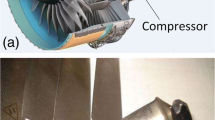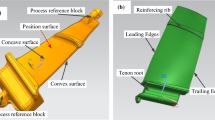Abstract
Precision forged blades are increasingly adopted in the field of aero-engine to save material quantity and improve machining efficiency. Edge shapes with sharply changed curvature of the precision forged blade are hard to be reconstructed when removing redundant blank material left by forging process. To address this problem, an original approach is proposed to predict and reconstruct an expected profile of the edge shape in adaptive machining. In this approach, the expected profile is obtained by reconstructing an axial curve and attaching blade thickness to this axial curve. In the first stage, the axial curve is first calculated point by point with the Newton-Raphson method. To predict the absent axial curve without measured data, the endpoint of the calculated axial curve is found according to an established deviation trend. Then, the absent axial curve is predicted as a spline curve with the minimum strain energy by solving an optimization problem. The expected profile is then reconstructed and smoothed in the second stage. In this stage, the blade thickness is calculated to establish a deformation trend of the forged blade. According to this deformation trend, the thickness of the absent part is then predicted and attached to the reconstructed axial curve to form an expected profile. After that, this expected profile is smoothed by solving a multi-objective optimization problem to satisfy industrial requirements and conditions. This approach is finally verified with a precision forged blade and compared with a referenced method. The results show that the proposed method can effectively reconstruct a qualified profile curve in machining a precision forged blade.
Similar content being viewed by others
References
Lu B, Ou H, Armstrong CG, Rennie A (2009) 3D die shape optimisation for net-shape forging of aerofoil blades. Mater Des 30(7):2490–2500
Xiao G, Huang Y (2016) Equivalent self-adaptive belt grinding for the real-R edge of an aero-engine precision-forged blade. Int J Adv Manuf Technol 83(9–12):1697–1706
Makem JE, Ou H, Armstrong CG (2012) A virtual inspection framework for precision manufacturing of aerofoil components. Comput Aided Des 44(9):858–874
BremerC (2000) Adaptive strategies for manufacturing and repair of blades and blisks. ASME Turbo Expo 2000. 45th ASME International Gas Turbine & Aeroengine Technical Congress (4): V004T01A010
Gao J, Chen X, Yilmaz O, Gindy N (2008) An integrated adaptive repair solution for complex aerospace components through geometry reconstruction. Int J Adv Manuf Technol 36(11–12):1170–1179
Javidrad F, Rahmati R (2009) An integrated re-engineering plan for the manufacturing of aerospace components. Mater Des 30(5):1524–1532
Ke Y, Zhu W, Liu F, Shi X (2006) Constrained fitting for 2D profile-based reverse modeling. Comput Aided Des 38(2):101–114
Ke Y, Fan S, Zhu W, Li A, Liu F, Shi X (2006) Feature-based reverse modeling strategies. Comput Aided Des 38(5):485–506
Khameneifar F, Feng HY (2014) Airfoil profile reconstruction under the uncertainty of inspection data points. Int J Adv Manuf Technol 71(1–4):675–683
Piegl L, Tiller W (1997) The NURBS book. Springer, New York
Hu SM, Li YF, Ju T, Zhu X (2001) Modifying the shape of NURBS surfaces with geometric constraints. Comput Aided Des 33(12):903–912
Mohaghegh K, Sadeghi MH, Abdullah A (2007) Reverse engineering of turbine blades based on design intent. Int J Adv Manuf Technol 32(9–10):1009–1020
Mohaghegh K, Sadeghi MH, Abdullah A, Boutorabi R (2010) Improvement of reverse-engineered turbine blades using construction geometry. Int J Adv Manuf Technol 49(5–8):675–687
Dong Y, Zhang D, Bu K, Dou Y, Wang W (2011) Geometric parameter-based optimization of the die profile for the investment casting of aerofoil-shaped turbine blades. Int J Adv Manuf Technol 57(9–12):1245–1258
Yun Z, Zhi-Tong C, Tao N (2015) Reverse modeling strategy of aero-engine blade based on design intent. Int J Adv Manuf Technol 81(9–12):1781–1796
Li Y, Ni J (2009) Constraints based nonrigid registration for 2D blade profile reconstruction in reverse engineering. J Comput Inf Sci Eng 9(3):031005
Yilmaz O, Gindy N, Gao J (2010) A repair and overhaul methodology for aeroengine components. Robot Comput-Integr Manuf 26(2):190–201
Rong Y, Xu J, Sun Y (2013) A surface reconstruction strategy based on deformable template for repairing damaged turbine blades. Proc Inst Mech Eng Part G J Aerosp Eng 228(12):2358–2370
Zhao Z, Fu Y, Liu X, Xu J, Wang J, Mao S (2017) Measurement-based geometric reconstruction for milling turbine blade using free-form deformation. Meas J Int Meas Confed 101:19–27
Li L, Li C, Tang Y, Du Y (2017) An integrated approach of reverse engineering aided remanufacturing process for worn components. Robot Comput Integr Manuf 48(1):39–50
Tai CC, Huang MC (2000) The processing of data points basing on design intent in reverse engineering. Int J Mach Tools Manuf 40(13):1913–1927
Celniker G, Gossard D (1991) Deformable curve and surface finite-elements for free-form shape design. ACM SIGGRAPH Comput Graph 25(4):257–266
Funding
This work was supported by the National Science and Technology Major Project on CNC Machine tool, China (no. 2013ZX04011031).
Author information
Authors and Affiliations
Corresponding author
Rights and permissions
About this article
Cite this article
Feng, Y., Ren, J. & Liang, Y. Prediction and reconstruction of edge shape in adaptive machining of precision forged blade. Int J Adv Manuf Technol 96, 2355–2366 (2018). https://doi.org/10.1007/s00170-018-1771-x
Received:
Accepted:
Published:
Issue Date:
DOI: https://doi.org/10.1007/s00170-018-1771-x




